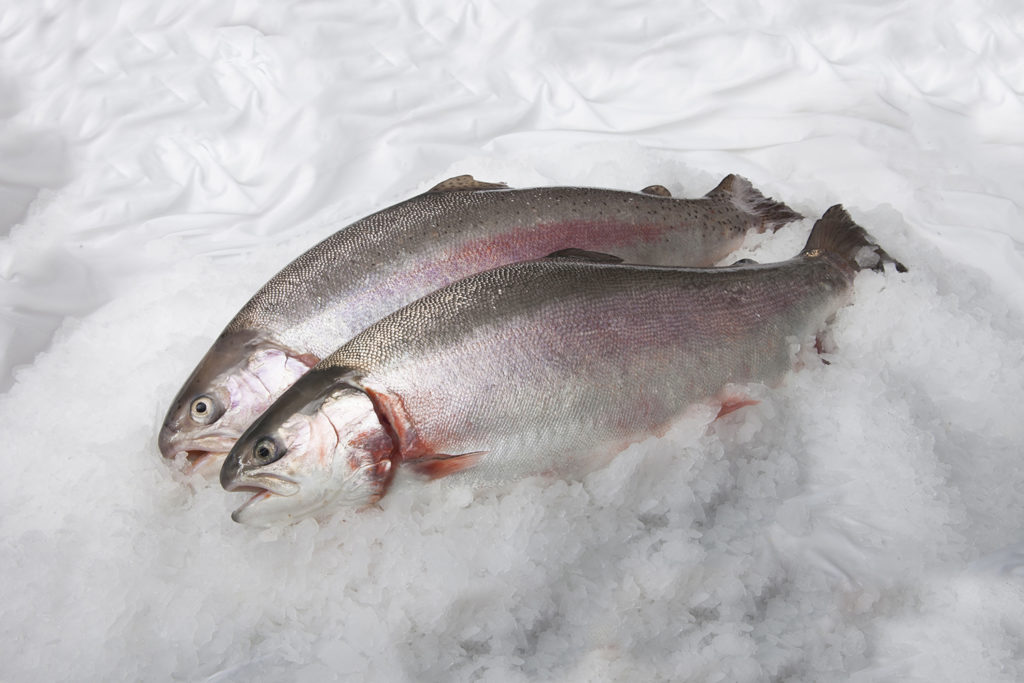Two-step aeration, carbon dioxide flushing improve water treatment

The production of Atlantic salmon smolts for stocking in sea cages has experienced a dramatic intensification over the last 20 years. While most of this production still takes place in single flow-through systems, more and more of these farms are introducing partial recirculation of the tanks to remove excess carbon dioxide.
Of about 230 licensed hatcheries in Norway, probably less than 5 percent have been turned into fully recirculating aquaculture systems, RAS. The number of RAS farms is rapidly growing, but no accurate distribution between applied technologies is available.
Alkalinity, water consumption
Along the Norwegian coast and fjords, the available freshwater sources for smolt production are very low in calcium. A majority of smolt farms have to increase the alkalinity of inlet water by adding compounds such as seawater, lime or silicate.
Another requirement in Norway is the heating of water through the winter season, especially in the north. The average temperature throughout the year in freshwater sources north of the Polar Circle in northern Norway is around 3 degrees-C. Thus, energy consumption is a vital cost element at many sites, and the potential energy recovery gain in RAS is attracting interest among the farmers.
Reduced water consumption is not just favorable for the water treatment costs at smolt farms. Most farms use lakes as inlet sources, but at large flow-through farms that produce up to 2 million smolts annually, there is a serious risk of seasonal water shortages. Especially in late summer and early autumn with high water temperature before the delivery of the “second half-year smolts, “the lack of water supply can be critical. The water consumption in such flow-through farms can easily exceed the drinking water demand of 200,000 people.

RAS technology
The Norwegian company Hobas A.S. recently delivered a state-of-the-art RAS farm for the production of 4 million salmon smolts annually. The farming concept was engineered to provide a relatively simple, low-cost design supported by global logistics.
Hobas has a factory in Sri Lanka that manufactures fiberglass products for the company’s land-based farms. The system is designed to be sent all over the world in a very cost-effective manner. Moreover, the “base panel” sections ease installation of the tanks on site.
New RAS farm

The Fjordsmolt RAS farm is now in its start-up period. The Hobas RAS system includes two-step aeration and carbon dioxide flushing to improve water treatment.
The smolt farm consists of six 12-meter-diameter tanks in two production lines. The volume of the individual tanks is 345 cubic meters for a total available production volume of 2,070 cubic meters. Both tank lines are also connected to separate moving bed biofilters with a water volume of 200 cubic meters. About 60 percent of the total biofilter volume is filled with substrate.
The Fjordsmolt farm recirculates 91 percent of the total water flow at a flow of 36.1 cubic meters per minute. Thus, the make-up water supply constitutes approximately 3.5 cubic meters per min. At this flow rate, the theoretical retention time in the tanks is approximately 52 minutes.
The farm produces 100-gram smolts at a tank density of about 70 kg per cubic meter. Water temperature ranges from 7 degrees-C during winter with the highest biomass and load to 17 degrees-C in summer, a time of lower biomass.
One of the biggest farms in Norway, Fjordsmolt RAS farm is also the first to implement the Cornell dual-drain system in all six tanks. During the next few years, the operating conditions at the farm will be studied, as well as the fitness of the smolts after transfer to the sea.
(Editor’s Note: This article was originally published in the November/December 2009 print edition of the Global Aquaculture Advocate.)
Now that you've reached the end of the article ...
… please consider supporting GSA’s mission to advance responsible seafood practices through education, advocacy and third-party assurances. The Advocate aims to document the evolution of responsible seafood practices and share the expansive knowledge of our vast network of contributors.
By becoming a Global Seafood Alliance member, you’re ensuring that all of the pre-competitive work we do through member benefits, resources and events can continue. Individual membership costs just $50 a year.
Not a GSA member? Join us.
Authors
-
Asbjørn Drengstig
Hobas Ltd.
P. O. Box 391
4067 Stavanger, Norway[111,110,46,115,97,98,111,104,64,100,97]
-
Asbjørn Bergheim
International Research Institute of Stavanger
Stavanger, Norway
Tagged With
Related Posts

Intelligence
Canadian salmon farmers: ‘Leave us out of your shutdown’
The potential of a salmon-farming ban in Washington state is being monitored closely next door, in British Columbia, where many more salmon farms operate. But they’re not worried about a spillover effect.

Innovation & Investment
Competitiveness comes at scale for RAS operations
Total RAS salmon production worldwide is less than half of 1 percent of total production. Many of the investors flocking to the sector now are new to fish farming, and confident in its potential.

Innovation & Investment
Developments in closed-containment technologies for salmonids, part 1
The recent 2017 Aquaculture Innovation Workshop in Vancouver brought together numerous stakeholders involved in and interested in fish farming – particularly salmonids – in the growing industry of closed-containment systems.

Innovation & Investment
Developments in closed-containment technologies for salmonids, part 2
In the second of a two-part series, Steven Summerfelt discusses various efforts to improve knowledge of closed-containment systems, innovations in fish feed and presents comprehensive concluding remarks.


